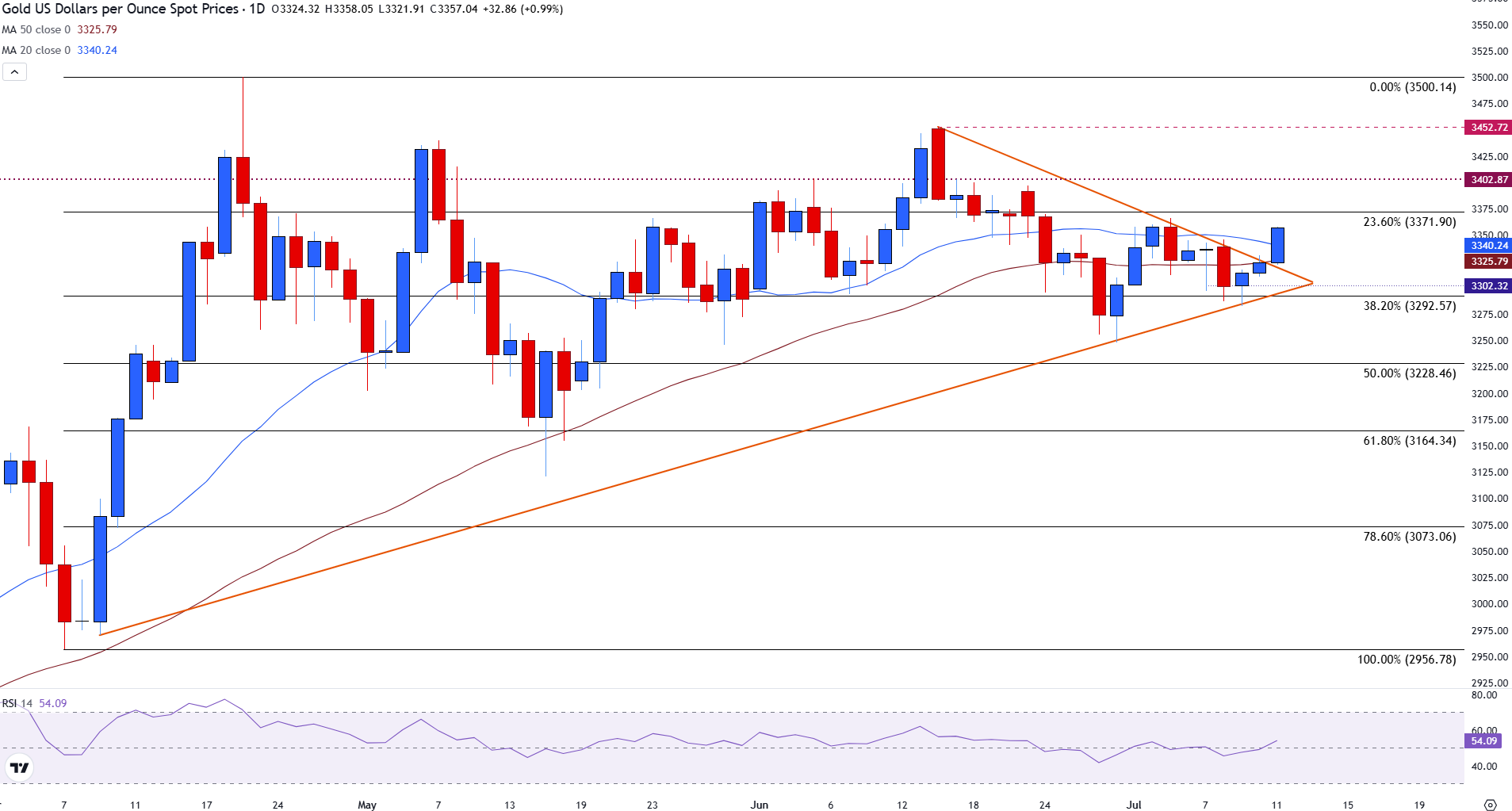- The price of gold benefits as commercial tensions increase its attractiveness as a safe refuge.
- President Trump threatens with 35% tariffs to Canadian imports that are not covered by the USMCA agreement (USA.-México-Canada).
- Xau/USD earns about 1% with $ 3,400 in view.
The price of gold (Xau/USD) shot on Friday, quoting above $ 3,340 at the time of writing, since commercial tensions and the demand for safe refuge have eclipsed the increase in US yields.
The US president, Donald Trump, announced on Friday a 35% tariff on Canadian imports, effective as of August 1, in a movement that shook global markets.
The decision is particularly significant since USA They are the largest commercial partner of Canada, representing 76% of Canadian exports in 2024, according to Statistics Canada.
Trump also warned about broader actions, stating: “We are simply to say that all the remaining countries will pay, either 20% or 15%. We will solve it now.”
His comments fed fears of a new wave of general tariffs, increasing the demand for gold as coverage against tariff risk.
Diario del Oro summary: the Xau/USD benefits from the demand for secure shelter against broader tariff risks
- The publication of the minutes of the June meeting of the Federal Reserve (FED) on Wednesday revealed a growing concern among those responsible for the monetary policy on the inflationary impact of the increasing tariffs. The minutes pointed out that “most participants highlighted the risk that tariffs could have more persistent effects on inflation.” The officials also reiterated that they are “well positioned to expect more clarity about the perspectives of inflation and economic activity.”
- According to the CME Fedwatch tool, the markets now see a 62.9% probability of an interest rate cut of 25 basic points in September. Until now this year, the Fed has maintained interest rates without changes in the 4.25%–4.50%range.
- Meanwhile, President Donald Trump climbed commercial tensions this week by announcing a 50% tariff on copper, effective on August 1, citing national security concerns. “Announced a 50% tariff on copper, effective on August 1, 2025, after receiving a solid national security evaluation. America, once again, will build a dominant copper industry,” Trump said in Truth Social on Wednesday.
- Brazil was also beaten with a 50%tariff, with Trump directly linking the movement to what he called the political persecution of former President Jair Bolsonaro, describing the procedures as a “witch hunt.” In addition, he ordered an investigation under section 301 on Brazil’s digital commercial practices, pointing out the possibility of additional tariffs.
- At a cabinet meeting on Tuesday, Trump confirmed that the deadline of the August 1 tariff would not be extended, stating that “everyone has to pay. And the incentive is that they have the right to negotiate in the United States.” Reinforcing this position, he wrote later: “Tariffs will begin to be paid on August 1, 2025. There have been no changes on this date, and there will be no changes.”
- For gold, these developments can continue to support the attractiveness of sure metal shelter.
Technical Gold Analysis: The Xau/USD breaks the resistance of the triangle, is directed to $ 3,400
Daily Gold Graph

Gold has exceeded the resistance of the symmetrical triangle, allowing the XAU/USD to recover the single mobile (SMA) of 20 days at $ 3,340.
The Relative Force Index (RSI) rises, pointing up about 53 in the daily graph, pointing out a slight upward impulse in Gold.
But risks are still firm. The setback of Fibonacci of 23.6% of the April upward trend is around $ 3,372, which could limit additional profits. Above, the psychological level of $ 3,400 and the maximum of June about $ 3,452 are the following objectives.
Meanwhile, if the US dollar (USD) manages to gain traction and improves the feeling of risk, so the 50 -day SMA could focus as a support at $ 3,325. Below that level, the attention focuses on the psychological level of $ 3,300 and the fibonacci decline of 38.2% in $ 3,292.
Tariffs – Frequently Questions
Although tariffs and taxes generate government income to finance public goods and services, they have several distinctions. Tariffs are paid in advance in the entrance port, while taxes are paid at the time of purchase. Taxes are imposed on individual taxpayers and companies, while tariffs are paid by importers.
There are two schools of thought among economists regarding the use of tariffs. While some argue that tariffs are necessary to protect national industries and address commercial imbalances, others see them as a harmful tool that could potentially increase long -term prices and bring to a harmful commercial war by promoting reciprocal tariffs.
During the election campaign for the presidential elections of November 2024, Donald Trump made it clear that he intends to use tariffs to support the US economy. In 2024, Mexico, China and Canada represented 42% of the total US imports in this period, Mexico stood out as the main exporter with 466.6 billion dollars, according to the US Census Office, therefore, Trump wants to focus on these three nations by imposing tariffs. It also plans to use the income generated through tariffs to reduce personal income taxes.
Source: Fx Street
I am Joshua Winder, a senior-level journalist and editor at World Stock Market. I specialize in covering news related to the stock market and economic trends. With more than 8 years of experience in this field, I have become an expert in financial reporting.







